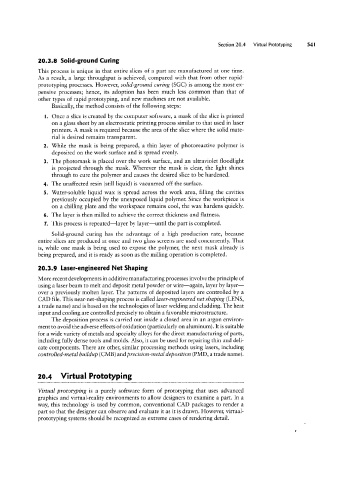Page 561 - 04. Subyek Engineering Materials - Manufacturing, Engineering and Technology SI 6th Edition - Serope Kalpakjian, Stephen Schmid (2009)
P. 561
Section 20.4 Virtual Prototypmg
20.3.8 Solid-ground Curing
This process is unique in that entire slices of a part are manufactured at one time.
As a result, a large throughput is achieved, compared with that from other rapid-
prototyping processes. However, solid-ground curing (SGC) is among the most ex-
pensive processes; hence, its adoption has been much less common than that of
other types of rapid prototyping, and new machines are not available.
Basicall Y , the method consists of the followin ste s:
P
g
I. Once a slice is created by the computer software, a mask of the slice is printed
on a glass sheet by an electrostatic printing process similar to that used in laser
printers. A mask is required because the area of the slice where the solid mate-
rial is desired remains transparent.
2. While the mask is being prepared, a thin layer of photoreactive polymer is
deposited on the work surface and is spread evenly.
3. The photomask is placed over the work surface, and an ultraviolet floodlight
is projected through the mask. Wherever the mask is clear, the light shines
through to cure the polymer and causes the desired slice to be hardened.
4. The unaffected resin (still liquid) is vacuumed off the surface.
5. Water-soluble liquid wax is spread across the work area, filling the cavities
previously occupied by the unexposed liquid polymer. Since the workpiece is
on a chilling plate and the workspace remains cool, the wax hardens quickly.
6. The layer is then milled to achieve the correct thickness and flatness.
7. This process is repeated-layer by layer-until the part is completed.
Solid-ground curing has the advantage of a high production rate, because
entire slices are produced at once and two glass screens are used concurrently. That
is, while one mask is being used to expose the polymer, the next mask already is
being prepared, and it is ready as soon as the milling operation is completed.
20.3.9 Laser-engineered Net Shaping
More recent developments in additive manufacturing processes involve the principle of
using a laser beam to melt and deposit metal powder or wire-again, layer by layer-
over a previously molten layer. The patterns of deposited layers are controlled by a
CAD file. This near-net-shaping process is called laser-engineered net shaping (LENS,
a trade name) and is based on the technologies of laser welding and cladding. The heat
input and cooling are controlled precisely to obtain a favorable microstructure.
The deposition process is carried out inside a closed area in an argon environ-
ment to avoid the adverse effects of oxidation (particularly on aluminum). It is suitable
for a wide variety of metals and specialty alloys for the direct manufacturing of parts,
including fully dense tools and molds. Also, it can be used for repairing thin and deli-
cate components. There are other, similar processing methods using lasers, including
controlled-metal buildup (CMB) and precision-metal deposition (PMD, a trade name).
20.4 Virtual Prototyping
Virtual prototyping is a purely software form of prototyping that uses advanced
graphics and virtual-reality environments to allow designers to examine a part. In a
way, this technology is used by common, conventional CAD packages to render a
part so that the designer can observe and evaluate it as it is drawn. However, virtual-
prototyping systems should be recognized as extreme cases of rendering detail.

